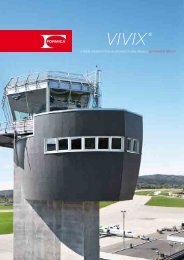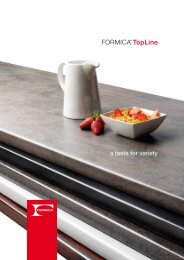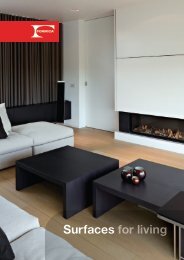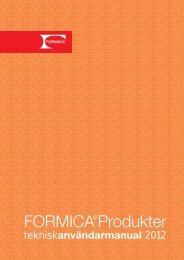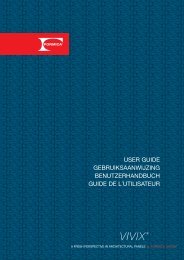Technical Information dispelling traditions - Formica
Technical Information dispelling traditions - Formica
Technical Information dispelling traditions - Formica
You also want an ePaper? Increase the reach of your titles
YUMPU automatically turns print PDFs into web optimized ePapers that Google loves.
formica_technical.qxd:formica_technical.qxd 28/11/08 16:01 Page 19MachiningGeneralBecause decorative laminates have a relatively hard surface, toolwear will be greater than with most wood based products. Forlonger life and better performance tungsten carbide tipped (TCT)saws and cutters should be used.Circular saws (fixed)The diameter of the saw blade should be as large as the machinewill allow (preferably not less that 150mm) so as to give the highestavailable tip speed. For example, a 300mm diameter saw bladewith a spindle speed of 3000 rpm will give a tip peripheral speed of45m/s.The sheet should be cut face up and held firmly down on themachine bed to prevent fluttering.Generally, saws should be fine toothed close pitched, withalternative teeth top bevelled. There are also a number of specialsaws which are ideal for cutting both unbonded and bondedlaminates, e.g. trapezoidal tooth (triple chip) saws.Circular saws (portable)Portable circular saws are particularly useful for on-site work.The direction of rotation of these saws requires the sheets tobe cut face down to avoid chipping. A fine toothed saw bladeis essential to reduce the need for subsequent finishing.Travelling sawsThe most convenient method of converting large sheets intosmaller size panels is to clamp the sheets and pass a travellingsaw across. These saws range from simple manually operatedmachines to the more sophisticated power operated clampedbeam saws and wall mounted saws.Band sawsThe band saw is ideal for rough cutting of shaped work.Manganese steel blades having hacksaw shaped teethare recommended.Spindle mouldersAll normal cutting tools can be used in the machining of laminates,but they must be tungsten carbide tipped. High speeds in theorder of 5000-8000 rpm give the best results. Milling heads andcutter blocks with disposable TCT cutters (both straight andprofiled) provide a convenient and relatively inexpensive methodof machining the edges of boards.Solid tipped cutter blocks with 4-10 blades, although expensive,soon pay for themselves in operations such as edge shooting,profiling and edge rebating of panels. They can be used for aconsiderable time before re-sharpening is necessary and theirweight gives them an inertia that minimises chatter.When working with laminates face down on the spindle table, it isadvisable to clamp the workpiece to a moving pad to minimise therisk of scratching.Portable jig sawsUsed to produce cut-outs of any size or shape. Like the portablesaw the cutting action is upwards, and therefore chip-free cuts aredifficult to achieve. Cuts should be made with a fine toothed blade,and with the face side down. Where this is not possible dueallowance should be made for the extra finishing necessaryto remove the edge chipping.High-speed fixed-head routersBench high speed fixed head routers may be used with singleor double flute TCT cutters having an optimum peripheral speedof 10-15m/s.Concentric cutters used in eccentric chucks give greaterclearance and therefore cool, clean cutting and longer intervalsbetween sharpening.Although primarily intended for cut-outs, these machines can beused for a variety of operations such as profiling, edge trimmingand grooving. It is not usually necessary for high speed routersto be used at speeds in excess of 18,000-20,000 rpm, if only toavoid the exact balancing requirements at speeds higher thanthese. For curved work it is advisable to rough cut the shape firston a band saw leaving 2-3 mm all round for subsequent trimmingon the router.Portable hand-held routersInvaluable for clean hole cutting, edge finishing and trimmingon-site, they are also very useful in the workshop for dealing withbulky assemblies. These routers can be fitted with small saws foron-site edge grooving of panels.Portable hand-held trimmersThese compact hand-held electrical trimmers which operate atspeeds of 18,000-20,000 rpm are designed principally for trimmingdecorative laminates. They are lightweight and easily operated withone hand. Depth of cut is usually controlled by an adjustable guidewheel, and TCT cutters are available for edge trimmingat angles ranging from 30°-90°.Edge trimmingThere are a number of machines on the market for volume edgetrimming. These machines will remove excess material from twoedges and bevel one or both edges, all in one operation.Drilling and hole cuttingHSS steep spiral drills with a point angle of 60°-80° instead of thenormal 120° are most suitable for small diameter holes. For largerholes (which are best cut from both sides), hole saws, cylindercutters, trepanning or fly cutters with a centre locating point,are all suitable.<strong>Formica</strong> Limited, Coast Road, North Shields, Tyne & Wear NE29 8RE. Tel: 0191 259 3000. Fax: 0191 258 2719.<strong>Formica</strong> is a registered trade mark of <strong>Formica</strong> Corporation or its subsidiaries.<strong>Technical</strong> Services Department April 2004.18




